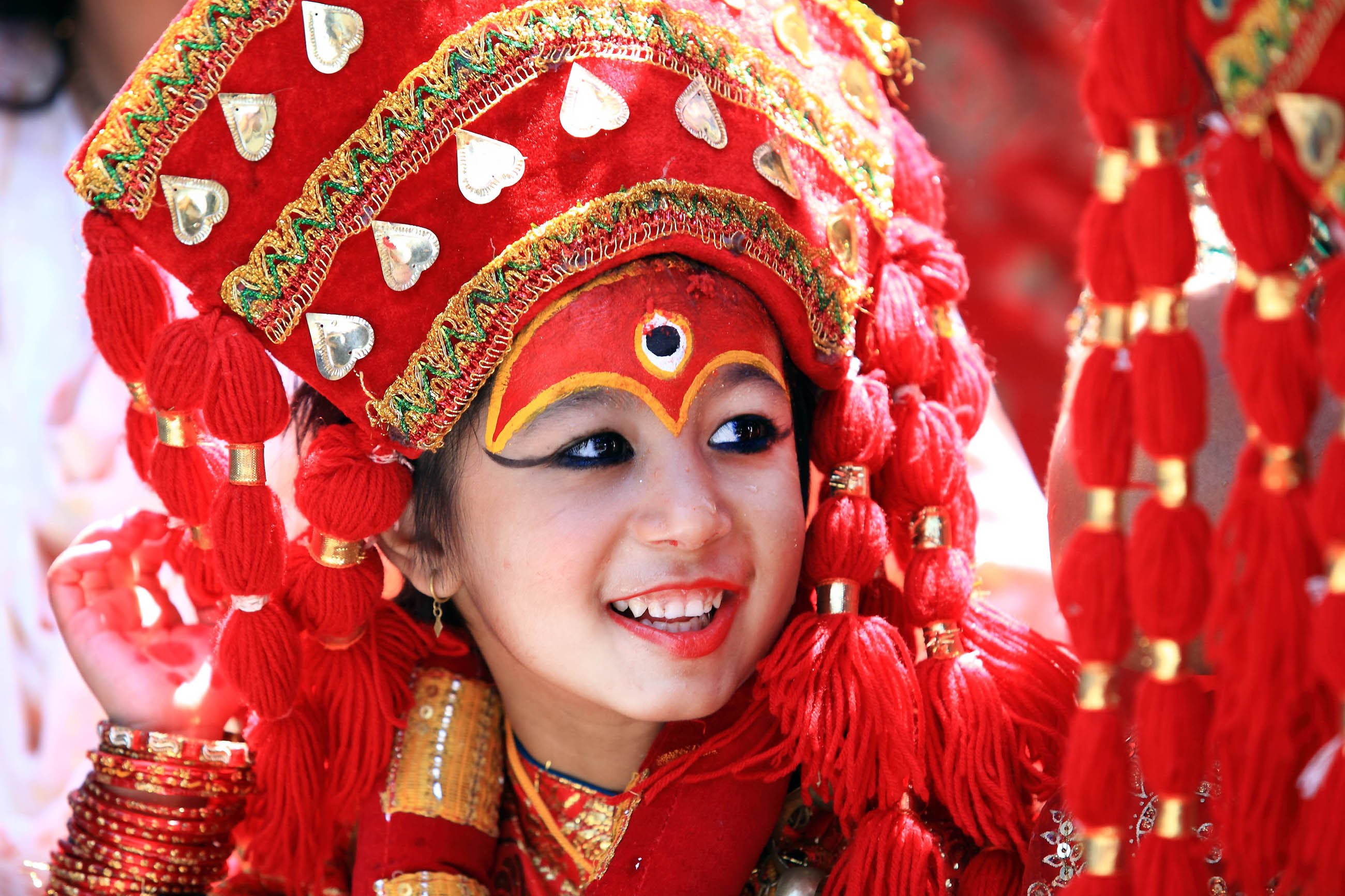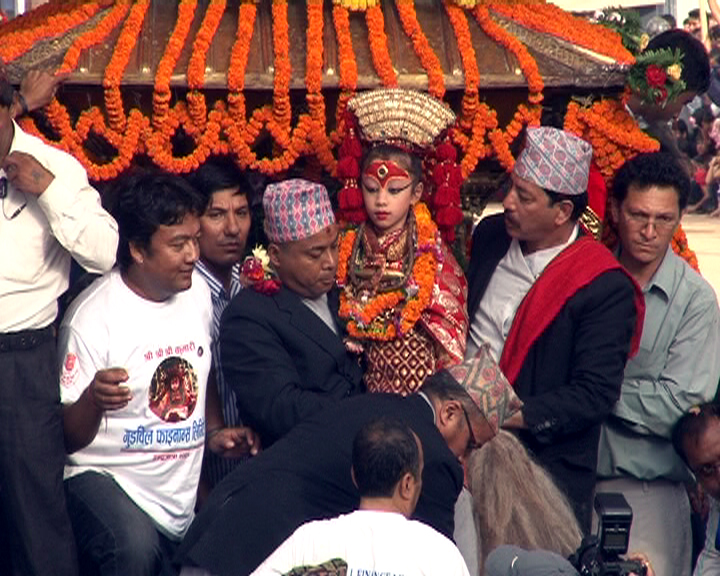- HOME
- Destination
- Adventure Activities
- About Us
- BLOGS
- CONTACT US

Nepal is a multi-cultural and multi-ethnic country. Nepal is a small Hindu nation, and there is so much diversity in the culture of people. Hindu is the most followed religion, Buddhism being next. Christianity, Sikh, Islam, and Kiranti are some of the other religion of Nepal. It may be a little unusual to hear, but in Nepal, there is such a strong belief in God and religion that even stones, rivers, lakes and trees are worshipped. There are 36 different ethnic group in Nepal and in those ethnic groups too, there are different tradition, culture, and customs they follow.
Among many such traditions, Kumari is one of the popular tradition, where a living goddess is worshipped.
In Bhaktapur, there is the tradition of worshipping young pre-pubescent girls as the manifestation of divine female energy. “Kumari” derived from Sanskrit word Kaumarya meaning “princess.”
Kumari is selected from the Shakya or Bajracharya caste of Newari community of Nepal. There are several Kumaris in different places of Nepal, but the Royal Kumari of Kathmandu is best known. The Royal Kumari lives in a palace in the center of the Kathmandu. After Royal Kumari, the Kumari of Patan is the second most important Kumari.
Generally, a Kumari is chosen for a day and worshipped accordingly on festivals like Navaratri and Durga Puja, but the Kumari of Kathmandu has a different practice. The Kumari of Kathmandu is worshipped as the incarnation of Goddess Taleju. It is also believed that when her first mensuration begins, the goddess leaves her body or sometimes serious illness or major loss of blood also cause the loss of deity.

Kumari Goddess is living god of nepal
The worship of Kumari began in Nepal from the 17th century. However, the tradition of Kumari-Puja or virgin worship has been for a much longer. There is evidence showing the virgin worship tradition for more than 2,300 years, making it the 6th century.
There are many legends about the tradition of Kumari. As per the most popular legends, King Jayaprakash Malla and his friend, the goddess Taleju, approached the king’s chamber one late night as he played a dice game, tripasa. Then, the goddess came along every night and played the game with him, with the condition that the king must not tell anyone regarding their meetings.
But, one night the king’s wife followed him to his chamber to find out about his secret meeting. The king’s wife saw the goddess and Taleju got angered by this. Goddess Taleju told the king that, if he wants to see her again or have her to protect his country, he would have to search her among the Shakya community of Newar group of Ratnawali, because she could be incarnated as a little girl among the girls. The king left his palace to amend with his patroness to search a young girl who is possessed by Taleju’s spirit.
There is another story about the disappearance of Taleju. There is a belief that goddess Taleju visited King Trailokyo Malla in human form and they played tripasa. But one night, the king made sexual advances towards the goddess, which caused great anger in her and she stopped visiting her. The king regretted his mistake and pleaded for her return. Finally, she agreed to appear in the body of a young virgin girl from the Shakya family.
Another story tells that there was a promiscuous king who was attracted to young girls. One time a young girl died during sexual intercourse. The accident left King with complete guilt, who repented the sin by saying the girl had returned to her goddess spiritual nature. Then, the king declared the creation of Goddess Kumari as a reminder to the world of the sacred nature of young girls and virginity.
The selection of Kumari is conducted by five senior Buddhist Vajracharya priest, the Panch Buddha, the Bada Guruji or Chief Royal Priest, Achajau, the priest of Taleju and the royal astrologer. The eligible girls are from the Shakya caste of Newar group of silver and goldsmiths. The eligible girl must be in excellent health, never have shed blood or been afflicted by any diseased, should be without any blemish and must not have lost any teeth yet. Girls who pass these basic requirements gets further examined for battis lakshanas/thirty-two perfections of the goddess.
In addition to all her perfections, her hair and eyes should be very black, dainty hands and feet, small and well-recessed sexual organs and a set of twenty teeth. The candidate is observed for her signs of serenity and fearlessness, and her horoscope gets examined too to ensure that it is complementary to the King’s. This all is important also there won’t be any conflicts as she must confirm the King’s legitimacy each year of her divinity.
Once a candidate gets chosen, she must undergo a rigorous test to prove herself that she indeed possesses the qualities to be the living vessel of the goddess. The greatest test comes during the festival of Dashain, on the kalrati/black night. During the kalratri, 108 goats and buffalos are sacrificed to the goddess Kali. The candidate is taken to the temple of Taleju and released into the courtyard where candles illuminate the severed heads of the animals and masked men are dancing. If the candidate doesn’t show any fear during the test, she has the qualities.
If the candidate passes the test, then she goes through the final test, where she must spend a whole night in a room alone among the heads of ritually slaughtered goats and buffalos without any fear. If the candidate doesn’t show any fear, then she has proven herself with fearlessness and serenity that typifies the goddess who is to inhabit her.
After passing this test, she must undergo the last test where she has to pick out the personal belongings of the previous Kumari from an assortment of the things put down before her. If she does this correctly, then there remains no doubt that she is the one.
After the Kumari is chosen, she must be purified so she can be an unblemished vessel for the goddess. Priests take her and undergo her with many secret Tantric rituals to purify her body and spirit from her experience. When all the rituals are completed, the goddess Taleju enters her body, and she is presented as the new Kumari. She gets dressed and made up as a Kumari and then leaves the temple of Taleju and walks across the square on a white cloth to the Kumari Ghar (House if Kumari) which will be her home during the time of her divinity.

Kumari goddess of Nepal
When a girl gets chosen as the Kumari, her life gets completely changed. She gets to leave her house only on ceremonial occasion and visit her family rarely in a formal way. Her friends are chosen from the Newar group, usually her caretaker’s children. She always gets dressed in red, wears her hair in a topknot and has the Agni chakchuu/fire eye painted on her forehead which symbolizes her special power.
The power of the Kumari is perceived to be very strong, and even her single glimpse is considered to bring the good fortune. People wait at the courtyard of her palace in the hope that she will pass by and glance down to them. The fortunate or better-connected petitioners pay a visit to Kumari, especially who are suffering from blood or mensuration disorders in a belief that she has special power over such illness. Also, Kumari gets visited by government officials and bureaucrats. Kumari lets them to touch her feet or kiss her as an act of devotion. During this time, Kumari is closely watched and her actions are interpreted as a prediction of the petitioners lives, following are the examples:
Your email address will not be published.Required fields are marked *
You must be logged in to post a comment.
0 Comments on "The Living Goddess of Nepal: Goddess Kumari"